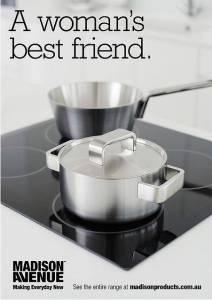Original Advertisement

The product being advertised is saucepan from Madison Avenue Cookware. The advertisement is specifically targeting female consumers while overlooking male consumers who enjoy cooking. As a way to appeal to female consumers, the ad introduces the saucepan as a woman’s best friend. This clearly shows how women are perceived as the ones who are responsible for household chores such as cooking and cleaning. In a bigger picture, the content of the advertisement reveals preconceived notions about appropriate gender roles in the domestic sphere. In society, women are expected to stay home and take care of domestic duties while men are expected to be the primary breadwinner. The advertisement highlights the traditional gender divisions regarding roles and further contributes in the construction of ideal gender roles in society (i.e. men as primary breadwinners and women as housewives). The ad neglects that men and women’s roles are changing despite the fact that many women began to enter the workforce and take over traditional male roles. Besides, the serious problem is that such advertisement helps spread gender stereotypes through media, making it easier for people to conform to social norms. A famous social theorist, Judith Butler, argues “the concept of gender as a behavior … [is articulated and] consolidated through daily repetition” (Hausman, 2003). This reveals how gender roles can be socially constructed and be easily reinforced through media. For this reason, the ad raises a need to challenge traditional gender roles by addressing how role and position of women have changed over time.
Here, I intend to challenge the existing gender norms by jamming the ad.
(Word Count: 263)
Jammed version of the Advertisement

For the culture jam, I have modified the original advertisement and came up with two different versions of the ad that targets male consumers. The first advertisement introduces toolbox as man’s best friend. The ad implicitly conveys that men are usually the ones who handle machine and associates such roles (i.e. construction worker and mechanics) with men. By doing this, I aim to portray a typical representation of male roles that are often characterized by the conceptions of masculinity. I also wanted to demonstrate a sharp contrast between the original and the modified advertisement to emphasize differences in male and female roles.
On the other hand, the second advertisement introduces apron as man’s best friend. The advertisement represents a reversal of gender roles where men are illustrated as if they are responsible for domestic duties. The swapped role is associated with stereotypical feminine traits such as nurturance and dependency whereas the traditional male role is “characterized by an emphasis on physical strength” (Franklin, 1984, p. 51). By swapping gender roles, I intend to break and challenge gender stereotypes that persist in society. In support, the article by Bainbridge (2014) also addresses the need for brands to drop stereotypical gender representations in advertising their product. As can be seen, I aimed to address that both men and women are capable of taking over different roles. People need to understand that there is no need to conform to traditional gender norms and that it is possible to break down the gender role barriers.
(Word Count: 251)
References
Bainbridge, J. (2014). What brands should know about the new woman consumer. Retrieved from http://www.campaignlive.co.uk/article/1282888/brands-know-new-woman-consumer#
Franklin, C. W. (1984). The changing definition of masculinity. New York: Plenum Press.
Hausman, B. (2003). “Gender and Gender Roles.” Dictionary of American History. Retrieved from http://www.encyclopedia.com/doc/1G2-3401801664.html